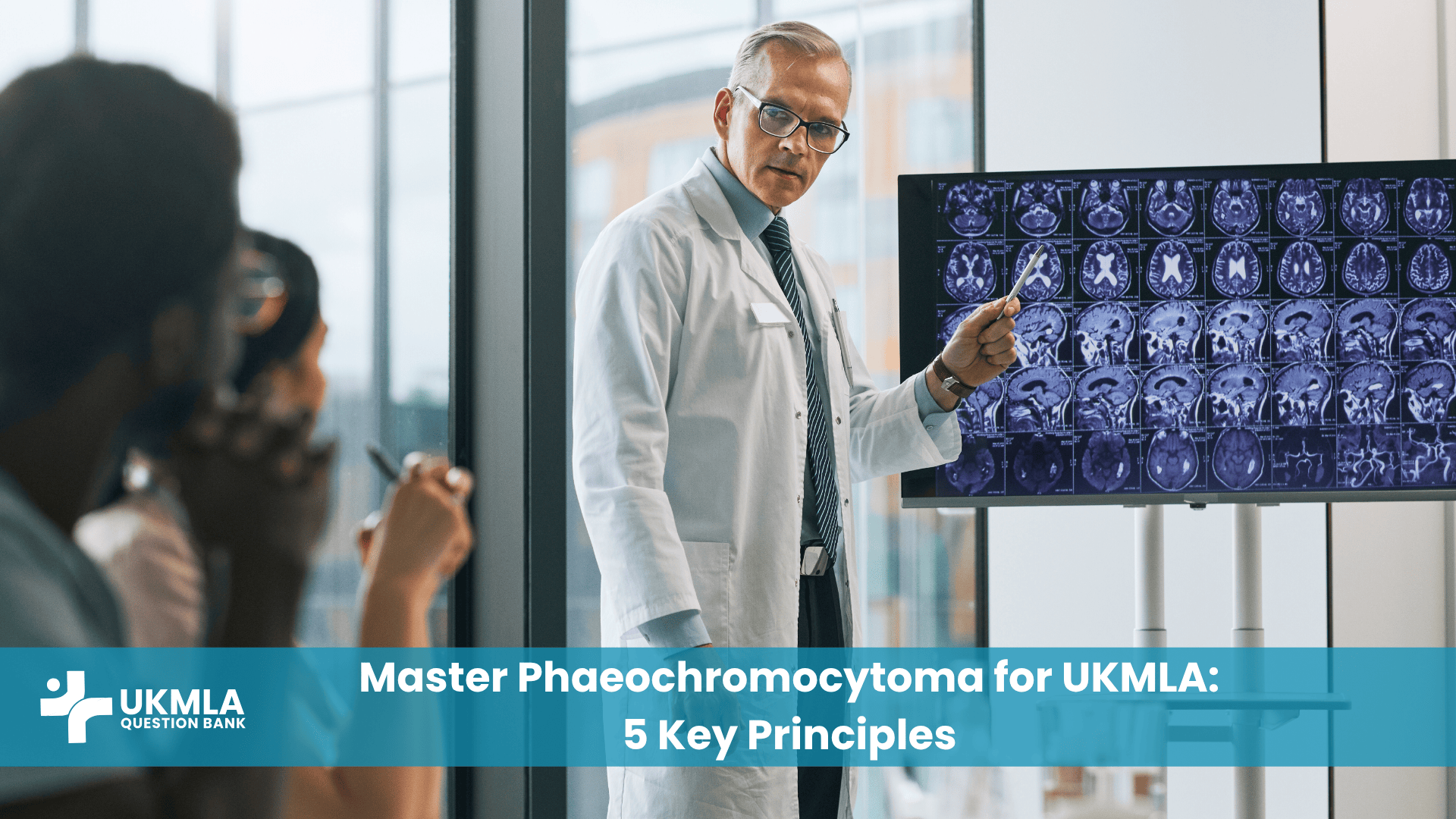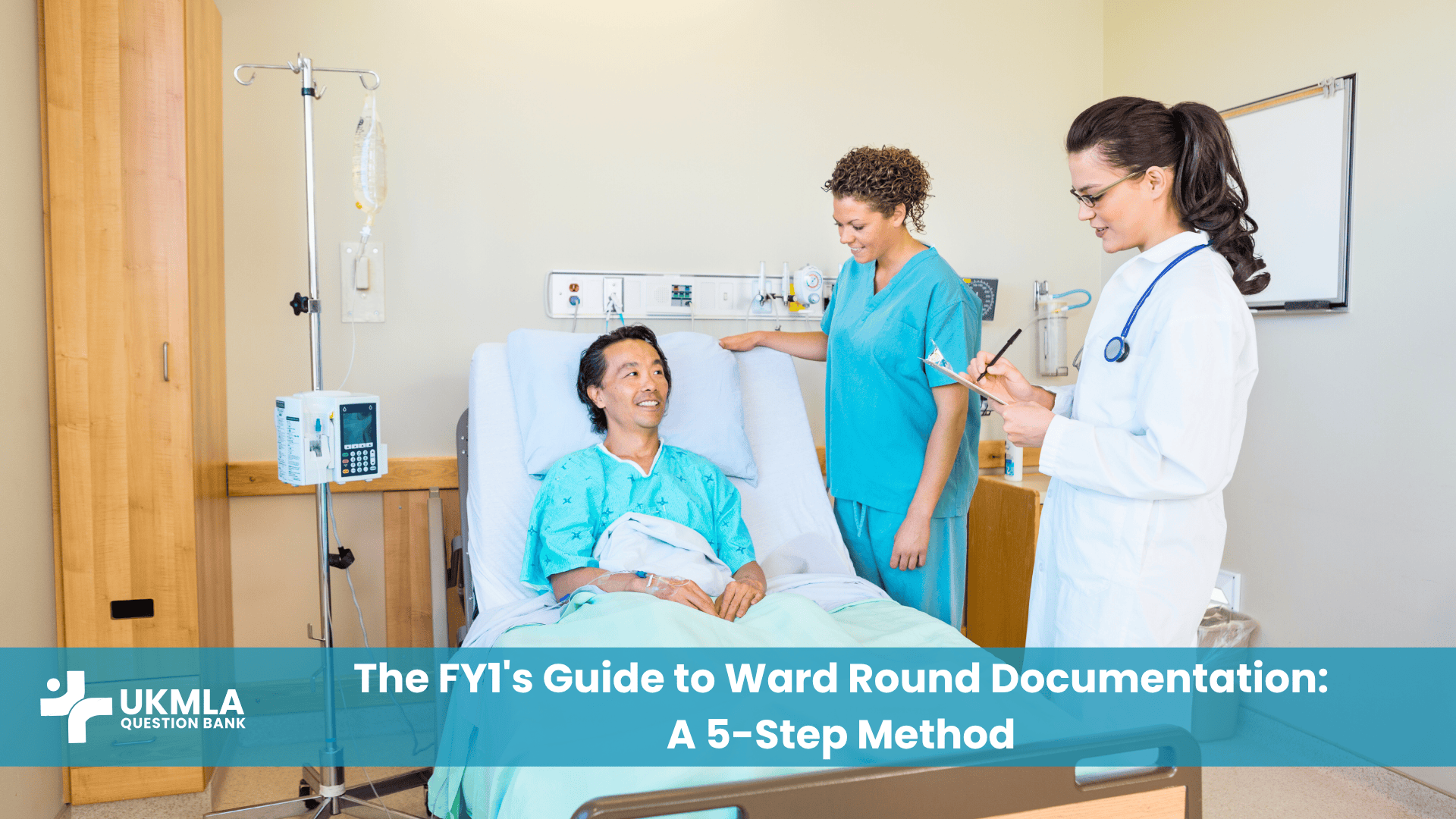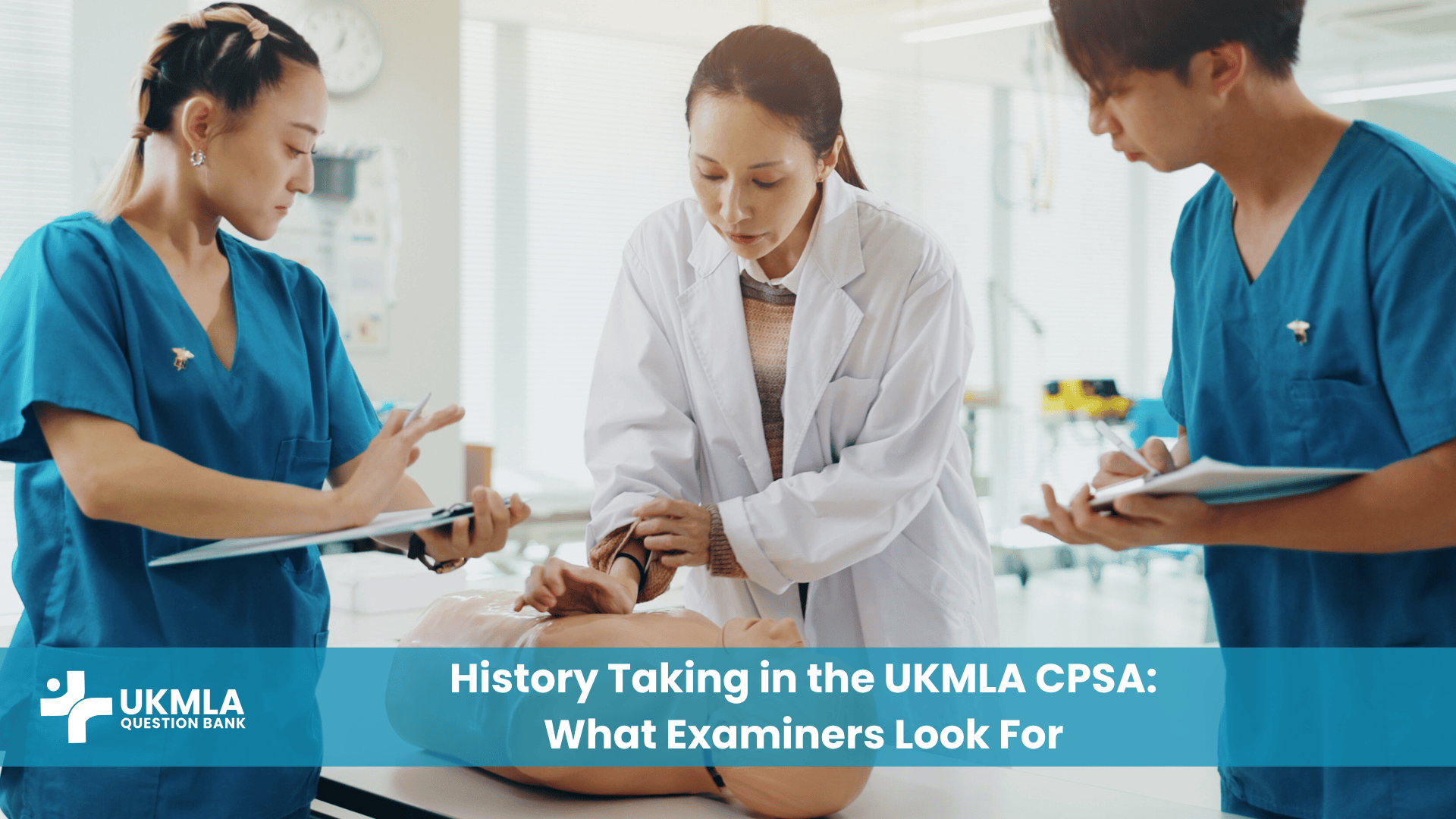Introduction
Mastering the topic of phaeochromocytoma for UKMLA is a classic rite of passage for medical students, and for good reason. While the condition itself is rare, it is a perfect exam topic because it tests a huge range of core clinical principles: understanding physiology, interpreting specific biochemical tests, applying crucial pharmacological rules, and recognising genetic patterns. The UK Medical Licensing Assessment (UKMLA) uses scenarios like this to assess your ability to think logically and act safely when faced with a complex presentation.
This guide is designed to demystify this “classic” tumour. We will break down everything you need to know into 5 memorable, high-yield principles. By understanding these key concepts, you will build the confidence to deconstruct any phaeochromocytoma-based SBA (Single Best Answer) question in your AKT (Applied Knowledge Test) and demonstrate your clinical acumen.
Table of Contents
ToggleThe 5 Key Principles of Phaeochromocytoma for UKMLA
To master this topic, you need a structured approach. These five key principles provide a framework that covers the vast majority of phaeochromocytoma questions you will face.
Principle 1: Recognise the Classic Triad of Presentation
A phaeochromocytoma is a rare catecholamine-secreting tumour that arises from chromaffin cells of the adrenal medulla. The key to diagnosis is recognising the symptoms caused by the episodic release of adrenaline and noradrenaline.
The Classic Triad: While not all patients present this way, the classic triad of symptoms is extremely high-yield for exams:
Episodic Headaches: Often described as severe, “pounding,” or “thunderclap” in nature, caused by surges in blood pressure.
Sweating (Diaphoresis): Profuse, drenching sweats that can occur without any obvious trigger.
Tachycardia (Palpitations): A sensation of a rapid, forceful, or fluttering heartbeat due to the direct effect of adrenaline on the heart.
Hypertension: This is the most common sign. The hypertension can be sustained, but it is classically labile or paroxysmal, meaning it comes in dramatic spells. A young patient with difficult-to-control hypertension, or a patient whose blood pressure dramatically fluctuates during an unrelated surgery, should always raise suspicion.
Other Symptoms: Patients may also report profound anxiety, tremor, pallor (due to intense vasoconstriction), and a sense of impending doom during these episodes. These paroxysms can be triggered by exercise, stress, certain foods (like those high in tyramine), or medications like beta-blockers and some anaesthetic agents.
Principle 2: Remember the “Rule of 10s”
This is a classic, high-yield mnemonic that summarises the key epidemiological and pathological features of phaeochromocytomas. While some of these percentages have been challenged by modern data (especially the familial link), they remain a very popular framework for exam questions.
Table 1: The Classic “Rule of 10s” for Phaeochromocytoma
| The “10%” Rule | Explanation |
|---|---|
| 10% are Bilateral | Most are unilateral, but 10% of patients have tumours in both adrenal glands. This is more common in familial syndromes. |
| 10% are Extra-adrenal | While most arise from the adrenal medulla, 10% arise from chromaffin tissue outside the adrenal gland. These are technically called paragangliomas. |
| 10% are Malignant | The majority of phaeochromocytomas are benign. Malignancy is defined by the presence of metastases (spread to non-chromaffin tissue like bone or liver), not by the appearance of the primary tumour itself. |
| 10% are found in Children | This is primarily a disease of adults (typically diagnosed between ages 30-50), but it can occur in children, where it is more likely to be bilateral and associated with a genetic syndrome. |
| 10% are Familial | Historically, 10% were thought to be inherited. We now know the figure is much higher (closer to 30-40%), but the “10%” rule is still widely quoted in exam contexts. |
Principle 3: The Biochemical Diagnosis is Key
Once you suspect a phaeochromocytoma, you need to know the correct investigation to confirm it.
The Best Test: The most sensitive and specific first-line test is the measurement of metanephrines (normetanephrine and metanephrine). These are the metabolites of noradrenaline and adrenaline. They can be measured in a 24-hour urine collection or in the plasma.
Why Metanephrines? Catecholamine release from the tumour is episodic, so a random blood test for adrenaline/noradrenaline could be normal between spells. However, the metabolism of these catecholamines to metanephrines is continuous within the tumour cells. This means that metanephrine levels are consistently elevated, making them a much more reliable diagnostic marker. For more on this, our guide on interpreting clinical data is essential reading.
Imaging: Once the biochemical diagnosis is confirmed, imaging (usually a CT or MRI of the abdomen) is used to locate the tumour.
Clinical Pearl: “A common exam trap is to offer a choice between measuring urinary catecholamines and urinary metanephrines. Always choose metanephrines as the superior initial test.”
Principle 4: The “Alpha Before Beta” Management Rule
This is the single most important, high-yield, and safety-critical management principle related to phaeochromocytoma for UKMLA. Getting this wrong in an exam (or in real life) is a major error.
The Problem: Patients with a phaeochromocytoma have massive stimulation of both alpha and beta-adrenergic receptors. Alpha-stimulation causes intense vasoconstriction (leading to hypertension), while beta-stimulation causes tachycardia.
The Danger of Beta-Blockers First: If you give a beta-blocker (e.g., propranolol) first, you will block the beta-2 mediated vasodilation. This leaves the alpha-1 mediated vasoconstriction completely unopposed, which can lead to a catastrophic hypertensive crisis and death.
The Correct Sequence: Therefore, the rule is absolute: alpha-blockade before beta-blockade.
Step 1: Start the patient on an alpha-blocker, such as Phenoxybenzamine, to control the blood pressure.
Step 2: Only once the patient is adequately alpha-blocked (as evidenced by a stable blood pressure and postural drop) can you safely add a beta-blocker to control the tachycardia.
This pre-operative medical management is essential to prepare the patient for the definitive treatment, which is surgical resection of the tumour. For more on the principles of these drugs, refer to our guide on high-yield pharmacology.
Principle 5: Consider the Genetic Link
A significant proportion of phaeochromocytomas are part of inherited genetic syndromes. Recognising these associations is a key part of a complete understanding.
The Importance of a Family History: Always ask about a family history of endocrine tumours or any of the conditions listed below.
Key Associated Syndromes: You should be familiar with the main genetic conditions associated with phaeochromocytoma:
Multiple Endocrine Neoplasia type 2 (MEN2A and MEN2B): These are autosomal dominant syndromes. MEN2A is associated with medullary thyroid cancer, hyperparathyroidism, and phaeochromocytoma. MEN2B is associated with medullary thyroid cancer, marfanoid habitus, mucosal neuromas, and phaeochromocytoma.
Von Hippel-Lindau (VHL) disease: An autosomal dominant condition associated with haemangioblastomas, renal cell carcinoma, and phaeochromocytoma.
Neurofibromatosis type 1 (NF1): An autosomal dominant neurocutaneous disorder.
Applying Your Knowledge to UKMLA SBAs
SBA (Single Best Answer) questions will test your ability to apply these principles.
A Note on Exam Strategy: “The UKMLA loves to test conditions with clear ‘rules’. The ‘Rule of 10s’ and the ‘alpha before beta’ rule for phaeochromocytoma are perfect examples of high-yield facts that are easy to build questions around. Master them.”
Deconstructing the Vignette: When you see a vignette with episodic headaches, sweating, and palpitations, or a young person with resistant hypertension, “phaeochromocytoma” should immediately be at the top of your differential diagnosis.
Avoiding the “Beta-Blocker First” Trap: Be extremely wary of any question that offers a beta-blocker as the initial management for a patient with a suspected phaeochromocytoma. It is almost certainly the incorrect (and dangerous) answer. For a clear UK-based summary, the NHS page on Phaeochromocytoma is an excellent and accessible resource.
Frequently Asked Questions (FAQ): Phaeochromocytoma
Because catecholamine (adrenaline/noradrenaline) secretion is episodic and can be normal between attacks. Metanephrines are the metabolites of catecholamines, and their production within the tumour is continuous, making their levels consistently high and a more reliable diagnostic marker.
A phaeochromocytoma is a catecholamine-secreting tumour of the adrenal medulla. A paraganglioma is a catecholamine-secreting tumour that arises from extra-adrenal chromaffin cells (e.g., in the abdomen or chest). They are treated in the same way.
The definitive treatment is surgical resection of the tumour. However, the patient must be medically optimised for at least two weeks beforehand with alpha-blockade (and subsequent beta-blockade) to prevent a hypertensive crisis during surgery.
While the classic triad is high-yield for exams, the single most common sign in real-life practice is sustained or paroxysmal hypertension.
Yes. An “adrenal incidentaloma” is an adrenal mass found on imaging performed for another reason. All such masses must be investigated to see if they are hormonally active, which includes screening for a phaeochromocytoma with metanephrines.
This is a second-line, dynamic test. In a normal person, clonidine (an alpha-2 agonist) suppresses sympathetic outflow and lowers catecholamine levels. In a patient with a phaeochromocytoma, the tumour continues to secrete catecholamines autonomously, so the levels are not suppressed.
A common mnemonic for MEN2A is PPM: Phaeochromocytoma, Parathyroid hyperplasia, Medullary thyroid cancer. For MEN2B, it’s MPM: Marfanoid/Mucosal neuromas, Phaeochromocytoma, Medullary thyroid cancer.
For benign, completely resected tumours, the prognosis is excellent, and the hypertension is often cured. For malignant phaeochromocytoma, the prognosis is more variable.
Yes. Patients should avoid drugs that can provoke a catecholamine crisis, such as tricyclic antidepressants, some anaesthetic agents, and unopposed beta-blockers.
Understand the 5 key principles in this guide. Then, use a high-quality UKMLA question bank to practice applying them to clinical vignettes. Pay special attention to questions that test the “alpha before beta” rule.
Conclusion
Mastering phaeochromocytoma for UKMLA is about understanding a condition of clear patterns and strict rules. By committing the 5 key principles to memory—the classic triad, the Rule of 10s, the biochemical diagnosis, the “alpha before beta” rule, and the genetic links—you will have a robust framework for success.
This is a topic where a little focused revision goes a long way. The concepts are logical and are tested frequently precisely because they are such a good measure of your ability to think physiologically and act safely. Use this guide to turn a rare tumour into an easy source of marks on your AKT.




